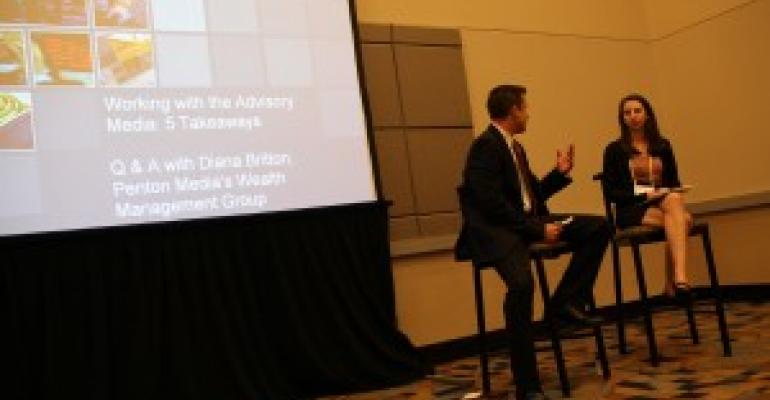
In attending the Peak Advisor Alliance (Ron Carson’s coaching program) conference in Omaha, Neb., this week, they asked me to participate in a Q&A session with Jason Lahita, head of the Los Angeles office for PR firm Cognito, to provide advisors with some do’s and don’ts on working with journalists. The back-to-back 40-minute sessions went off this morning without a hitch. Here are some of the questions they asked me, and some of my answers, which should also provide some value to our own audience:
Jason Lahita: You speak to advisors day in and day out – what are you looking for when speaking to an advisor? Topics, level of engagement, qualifications, etc. . .
Diana Britton: It’s an interesting dance because a lot of advisors have to filter comments through their compliance departments, and their comments often come out bland and not what we want. We want to talk to people who can give us a real, honest picture of what’s on in the industry in clear, concise way. We get real value from people who will talk to us without necessarily being quoted but who can help us mold story ideas and provide guidance on what’s happening behind the scenes. Advisors are our boots on the ground, so to speak.
JL: We counsel our clients to prepare properly for interactions with reporters by doing some homework on their background, previous articles, topics of interest and to have some key messages ready as a fall-back point of reference during the interview – would you agree that doing these things could increase the value of the conversation?
DB: Sure. I would also say that it helps to know what we cover and the types of stories we write. From our perspective, we don’t write a lot of glowing profiles of single firms or new investment products. At Registered Rep., we try to differentiate ourselves in the marketplace by writing longer, analytical trend stories that include competitors and examples.
JL: What is the most common mistake spokespeople/sources make in a media interview? Can you detail one horrible mistake, anonymously of course!
DB: One pet peeve of mine is when sources ask to see the article and/or check quotes. First of all, we can’t show sources whole articles; that’s just not the way we work. I can send over quotes for you to check for accuracy, but oftentimes, this turns into an editing session and sources can sometimes get really nitpicky and change things dramatically in terms of style and content. That’s not what we want. One time I interviewed an advisor, which I had quoted directly from a tape recorder. After he had seen the piece online, he sent me back the article in a word document, full of track changes, most of which were just suggestions/comments, not inaccuracies. Let us do the editing, not you.
JL: What result should a contributing source expect from an interview, at the core level – in other words, a quote, something more. . . ? Help me manage their expectations.
DB: It really depends. In some cases, we might not even quote the person because we run out of room or their comments just don’t really fit with the topic. In those cases, I would just say don’t be discouraged or give up on us. The conversation could lead to another story, or we could use you for another story down the line. And a lot of times, we’re just trying to get background information on a topic or get some general sense of trends in the industry, which may not always lead to a quote. It’s more about developing a relationship. Other times, we might heavily quote the person.
JL: What one thing can spokespeople/sources do to improve the quality of their interviews?
DB: Answer the question directly, and don’t talk around the issue. There are some firms (won’t name any names) that try to be helpful, but they’re really not helpful. In other words, they pretend to make their executives available, but in fact they aren’t saying anything useful. Speak candidly and honestly or don’t bother. It wastes everyone’s time. Also, we like examples. The best stories are told through people.
JL: What makes for an interesting press release, or piece of news? Do you have an example of an eye grabbing topic that you knew you had to follow up on?
DB: The best type of story is one that goes against conventional wisdom: We thought it was X, but it was really Y. Press releases for the most part aren’t helpful, unless the writer thinks like an editor and adds good content. Again, we’re looking for trend pieces that include competitors.
JL: Because I promised everyone here five fundamentals of PR, I’d like to get these in:
- Prepare a targeted media list of outlets you respect, across 3 key categories – advisory, local biz/finance and broader national business.
- Start to follow the topics they are covering, following journalists you like via social media, like Twitter
- Prepare thoroughly for every media interaction
- Establish up to three key messages, identifiers for your business, and how you differentiate yourself as an advisor
- Start careful contribution to the discussions taking place, via company blog, penning contributed articles or just commenting on a piece you find interesting or have an opinion on.

